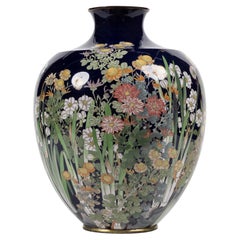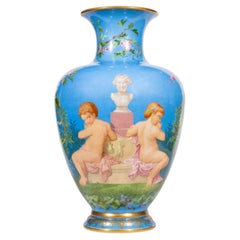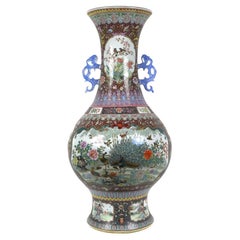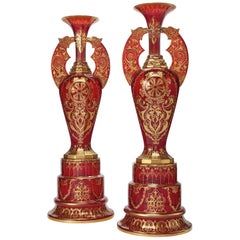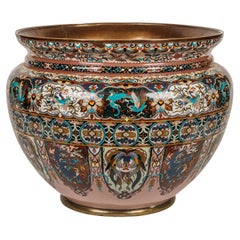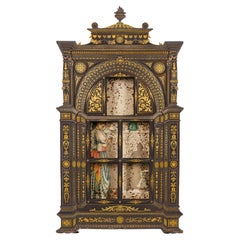Solomon Treasure Decorative Objects
to
14
86
1
4
55
27
1
7
2
3
3
2
1
1
1
1
1
72
28
23
21
20
87
66
41
14
11
10
Height
to
Width
to
87
87
87
7
4
3
3
2
An Exquisite Quality Meiji Period Japanese Cloisonne Enamel Bud Vase
Located in Queens, NY
Presenting a truly remarkable piece, this large exquisite quality cobalt ground Meiji Period Japanese cloisonne Enamel Bud Vase. This magnificent artwork embodies the timeless beauty...
Category
Antique 19th Century Japanese Meiji Vases
Materials
Enamel
A Large French Baccarat Opaline Glass Hand-Painted "Bacchanale" Vase, by Roussel
By Cristalleries De Baccarat
Located in Queens, NY
A Large French Baccarat Opaline Glass Hand-Painted "Bacchanale" Vase, by Roussel, circa 1885.
Presenting an exquisite and highly coveted piece of artistry, behold the large French O...
Category
Antique 19th Century French Napoleon III Vases
Materials
Glass
Monumental Chinese Famille Rose Porcelain "Peacock" Palace Vase
Located in Queens, NY
A monumental Chinese famille rose porcelain "Peacock" palace vase, Republic period.
Magnificent quality and palace sized Chinese hu-form vase with side h...
Category
Late 20th Century Chinese Qing Ceramics
Materials
Porcelain
Monumental Pair of Ruby Red Gilt Bohemian "Alhambra" Cut Glass Vases on Stands
Located in Queens, NY
A monumental pair of ruby red gilt Bohemian "Alhambra" cut glass vases on stands,
circa 1910.
Of Alhambra form, in the Moorish / Islamic tast...
Category
Early 20th Century Czech Moorish Vases
Materials
Cut Glass
Monumental Meiji Period Japanese Cloisonne Enamel Jardiniere
Located in Queens, NY
A Monumental Meiji Period Japanese Cloisonne Enamel Jardiniere.
This monumental Meiji Period Japanese cloisonne enamel jardiniere is...
Category
Antique 19th Century Japanese Meiji Planters, Cachepots and Jardinières
Materials
Enamel, Copper
Placido Zuloaga, an Extremely Rare Spanish Gold and Silver Damascened Frame
By Plácido Zuloaga 1
Located in Queens, NY
Placido Zuloaga, An extremely rare Spanish gold and silver damascened window frame, in the Alhambra / Islamic taste, circa 1880.
The interior is lined and fitted with an orientalist artwork throughout.
Signed PZ on the reverse.
Placido Zuloaga was a renowned Spanish metalworker and damascene artist known for his exceptional skills in working with gold and silver and for creating intricate and ornate designs on metal surfaces using a technique called damascening.
One of Zuloaga's works is this rare gold and silver damascened frame that he created in the late 19th century. The frame is decorated with intricate designs in silver and gold, creating a stunning contrast that is characteristic of Zuloaga's work.
The frame is a remarkable example of Zuloaga's artistry and skill, as well as his mastery of the damascening technique. The technique involves inlaying silver or gold wire into the surface of the metal, creating intricate and detailed designs that are both beautiful and durable.
Zuloaga's work was highly sought after during his lifetime and is still highly valued today. His pieces are considered to be some of the finest examples of damascene artistry in the world, and his legacy continues to inspire and influence metalworkers and artists today.
His works are in private collections and in museums worldwide.
Comparative Literature:
James D. Lavin, The Art and Tradition of the Zuloagas, Spanish Damascene...
Category
Antique 19th Century Spanish Islamic Picture Frames
Materials
Steel, Iron
Rare and Important Italian White Marble Bust Sculpture of Jesus Christ, C. 1850
Located in Queens, NY
Rare and important Italian white marble bust sculpture of Jesus Christ, C. 1850.
A truly exceptionally carved marble relief of Holy Jesus Christ. ...
Category
Antique 19th Century Italian Renaissance Busts
Materials
Marble
F. Barbedienne, A Suite of Three French Ormolu and Champleve Enamel Jardinieres
By Ferdinand Barbedienne
Located in Queens, NY
Ferdinand Barbedienne, An Exquisite Suite of Three French Ormolu and Champleve Enamel Jardinieres / Garniture C. 1870, The Design Attributed to Louis Constant Sevin.
Comprising of t...
Category
Antique 19th Century French Napoleon III Planters, Cachepots and Jardini...
Materials
Bronze, Enamel, Ormolu
Exquisite and Large Indian 22k Gold, Enamel, and Diamond Snuff Box, Jaipur
Located in Queens, NY
An Exquisite and Large Indian 22K Gold, Enamel, and Diamond Snuff Box, Jaipur
A very fine quality 22k gold box set with 40 diamonds, painted with the fi...
Category
20th Century Indian Anglo-Indian Snuff Boxes and Tobacco Boxes
Materials
Gold, Enamel
Exceptional White Marble Figural Sculpture Clock, "Nubian Slaying the Lion"
Located in Queens, NY
An exceptional and monumental white marble figural sculpture clock, "A Nubian Slaying The Lion" by Jean-Joseph Jacquet (Belgian, 1822–1898), c...
Category
Antique 19th Century Belgian Figurative Sculptures
Materials
Marble
An Exquisite and Rare French Louis XVI Style Ormolu-Mounted Bloodstone Inkwell
Located in Queens, NY
An Exquisite and Rare French Louis XVI Style Ormolu-Mounted Bloodstone Inkwell, circa 1875.
A truly exceptional and jewel like quality inkwell encrier, made with the finest ormolu, mounted on bloodstone. A true collectors and one of a kind piece.
Revival of the ancient régime in the late 19th century was paramount to the French furniture and bronze casting firms of the Belle Epoque. Imitation in the highest regard and replication of those tastes and styles was prevalent throughout the Paris Faubourg, where the most talented bronziers and ébénistes established their workshops. The present inkwell encrier recalls the late 18th century's obsession with hardstones - a taste expounded above all by the duc d'Aumont and, subsequently Marie-Antoinette. Such hardstone-mounted pieces, reminiscent of Renaissance schatzkammer objects, enjoyed a revived popularity at the end of the 18th century through the impetus of both the marchands-mercier and, more importantly, the hôtel des Menus-Plaisirs, where the duc d'Aumont himself established a workshop in 1770 specializing in the cutting and polishing of precious hardstones.
This exceptional inkwell encrier, sumptuously-mounted with finely chased gilt-bronzes, incorporates a highly-prized material such as bloodstone.
Sometimes called the Sunstone, the meaning of Bloodstone comes entangled in fascinating history. The Ancient Greeks held the Bloodstone as a gem with glorious powers. They referred to it as Heliotrope, which directly translates to Sunstone. It was believed to have heavenly healing powers gifted by the gods and most certainly when it came to healing all things related to the blood. Even as we move forward into the Middle Ages, the Bloodstone takes another mystical story under its wing. It was believed to be formed from Christ's blood. It was said that during the Crucifixion, a few red spots of his blood dripped...
Category
Antique 19th Century French Napoleon III Inkwells
Materials
Bronze, Ormolu
Mellerio Paris, A French Gold, Diamonds, Silver, and Smoky Quartz Carved Horse
By Mellerio
Located in Queens, NY
Mellerio Paris, A French Gold, Diamonds, Silver-Gilt, Rock-Crystal, Jade, Mother-Of-Pearl and Smoky Quartz, Carved Horse Sculpture, Jeweled Mounted Object.
An extremely rare and unique, one of a kind French gold, diamonds, Silver-gilt, rock-crystal, jade, obsidian, mother-of-pearl, and smoky quartz carved jeweled sculpture "CHEVAUX DE LEGENDE", "A Legendary Horse" by Mellerio, Paris, circa 1991.
Sitting on black obsidian base, the solid rock-crystal slab is finely applied with a carved smoky -quartz and jade horse with a harness mounted in 18k gold, brilliant -cut diamonds, rubies, turquoise, and amethyst chains and pendants. The top columns adorned with 18k gold and brilliant cut diamond pendants, the bottom with gold and mother of pearl plaques. The obsidian base with a plaque engraved: CHEVAUX DE LEGENDE" / N° 05 / MELLERIO DITS MELLER / PARIS / 5003 D
The piece is in excellent condition and comes with a custom made wood case made for transport. It's very elegant and has French hallmarks throughout. A truly magnificent piece.
Measures 10.5" high x 8.5" wide x 4" deep
Founded in France in 1613 by the descendants of Italian immigrants from the Vigezzo Valley in the north of Italy, Mellerio is one of the oldest jewellery houses in Europe. The family business soon attracted the attention of the Royal Court and Marie Antoinette herself reportedly purchased a precious bracelet featuring 7 cameos surrounded by rubies in 1780. Later on, in the 19th century, Mellerio became the official supplier of the French Royal family and the Court of Netherland.
Mellerio creates many jewellery items, all set with rare gems such as peridots, amethysts, aquamarines, citrines and topaz, applying for a patent, the flexible stem, a very supple and light jewellery mechanism. Mellerio remains also well known for their spectacular series of Art Nouveau jewels, created at the beginning of the 20th century, as well as for the creation of trophies rewarding some of the greatest footfall and tennis players of history. In 1993, the jewellery house launched their first watch collection.
Today, Mellerio has stores in Paris, Japan and Hong Kong.
July 14, 1789: this date is known throughout the world as the beginning of the French Revolution. According to a ledger belonging to House of Mellerio, this was also the day that the jeweler sold a golden key to the Comte de Coutance for 10 livres. This ledger, as well as inventories dating as far back as 1768, are the jeweler’s oldest archives. These archives have continued to grow over the years, as the House, established on rue de la Paix in Paris, still lives on today, still in the hands of the same family from Craveggia, in the North of Italy.
The tumultuous history of the Mellerio family in France probably goes as far back as the Italian wars of the Renaissance, but the first official document proving their commercial activity in Paris dates back to 1613. This document is the famous royal warrant awarded by Marie de Medici to a number of Italian families established along the rue des Lombards, including the Mellerios, allowing them to sell “small jewelery items”, therefore granting them a small exception to the traditional monopoly enjoyed by Parisian jewelers. At that time, powerful corporations regulated the operations and customs of Parisian business, but thanks to this exceptional warrant, the Mellerios managed to escape the confines of this framework. Today, this wax-sealed document is kept at the city hall of Craveggia.
From 1613 to the Revolution, the Mellerios lived between France and Italy. The corporations tried many times to put an end to their trade privileges, but all in vain, as a dynasty of sovereigns renewed the warrant. Always marrying and often retiring in Craveggia, the Mellerios continued to maintain their jewelry business in Paris. At first, they did this without a shop. Wearing backpacks (wooden boxes divided into small compartments where jewels were kept), they would tour town fairs around Paris and royal castles.
This is how Jean-Baptiste Mellerio (1765-1850) is said to have sold a bracelet set with rubies and Antique cameos to Marie-Antoinette, which still exists today. Many elements seem to prove the veracity of this anecdote. The queen was particularly fond of cameos, which cover the entire background of her famous jewelry cabinet, and ruby was her favorite stone after diamond. The famous bracelet, reacquired a few years ago by the House of Mellerio, is indeed an 18th century jewel, set with antique cameos representing the profiles of Roman emperors. Two branches of the family were operating in Paris during this time, under the reign of Louis XVI: that of Jean-François (1746-1828), the paternal ancestor of the current Mellerios, and that of Jean-Baptiste (1765-1850).
The French Revolution forced them to return to Italy. However, both Jean-Baptiste and François Mellerio (1772-1843), who was the son of Jean-François, were eventually able to return to Paris after the founding of the Consulate. Jean-Baptiste opened a shop at the Iron Crown of rue Vivienne, and François opened his at the Palais des Tuileries, rue du Coq Saint-Honoré. His well-organized order books give an idea of his high-ranking clientele during the “Old Regime”, among which were the Comte and Comtesse Octave de Segur, the Marquise (later Duchess) de Tourzel, former governess of the royal children, and her daughter, the Comtesse de Bearn, the Craufurds -who organized the flight to Varennes, the Duc and Duchess de Gramont, the Comtesse de Boigne, and Madame de Souza, Talleyrand’s mistress.
We also see the names of the imperial family: Empress Josephine, the Queen of Holland, Princess Elisa, Caroline and Pauline. At that time, the House of Mellerio specialized, among other things, in the trade of antique cameos, a newly fashionable genre of jewel that captured the imagination of all the princesses and noble women of the time.
The years of the Restauration and July Monarchy were among the most glorious. The Bourbons were back on the throne, and the clientele of the House of Mellerio had regained its former wealth. Mellerio supplied Louis-Philippe, Duke of Orléans, as well as his mother, wife and sister, with sumptuous jewels, including a set of emeralds made piece by piece, while the Duke of Bourbon, last prince of the House of Condé, offered diamonds to his mistress, the scheming Baronne de Feucheres, and Monsieur de LaFayette also bought cameos for one of his granddaughters. For the first time, Mellerio ventured into the world of arts in 1815, when Carlotta Grisi, a famous dancer who created Giselle, as well as an actress named Rachel, bought jewels at the Mellerio store on rue de la Paix.
1848 marked a new turning point. France once again became a Republic. François Mellerio handed the company over to his son, Jean, and the latter decided to travel to Spain to build a new clientele. He later became one of the jewelers of the royal family, and met Eugénie de Montijo, who remained a faithful client when she became empress of the French people. The Imperial years were lavish. During the Second Empire, Paris was a pageant of crinoline dresses designed by Worth, while jewels by Mellerio, Worth’s neighbour on the rue de la Paix, adorned the noble women of the Tuileries court.
The Empress bought pearls. Mathilde Bonaparte...
Category
20th Century French Mounted Objects
Materials
Rock Crystal, Jade, Quartz, Gold, Silver
Important Monumental Art Nouveau Ormolu-Mounted Ceramic "Exhibition" Vase
By Charles Pillivuyt & Cie, Louis Chalon, Paul Louchet
Located in Queens, NY
An Important and Monumental Art Nouveau Ormolu-Mounted Ceramic "Exhibition" Vase, C. 1895
This important and monumental vase was done by four different artists in the late 19th century:
Alphonse Adolphe Lamarre, French, 1837 - 1912 (Artist who designed the vase)
Paul Louchet, French (founder of bronze mounts) (Founder)
Charles Pillivuyt Porcelain Manufactory, French, Paris, 1853 - 1922 (Manufacturer)
Louis Chalon, French, born 1866 (modeler of mounts) (Modeler)
"An Art Nouveau Collaboration"
The vase in this case is an exceptional example of the collaboration between numerous artists during the late 19th century. The ceramic was made by Alphone Adolphe Lamarre (1837-1922) for the Charles Pillivuyt Porcelain Manufactory; the gilded bronze mounts, modeled by sculptor Louis Chalon and cast by Paul Louchet.
Spectacularly mounted naturalist vase; the base dressed and balustered, the neck finished in double openwork bulb, the surface describing sinuous reliefs. Polychrome glazed ceramic in Beige, blue, and green. The shoulder is decorated with a gilded bronze roundel with five ormolu bronze female...
Category
Antique Late 19th Century French Art Nouveau Vases
Materials
Bronze, Ormolu
A Rare Pair of French Ormolu-Mounted Blue John Vases Candlesticks, C. 1870
By Matthew Boulton
Located in Queens, NY
A Rare Pair of French Ormolu-Mounted Blue John Vases / Candlesticks, C. 1870, In the stye of Matthew Boulton.
These rare and extremely elegant garnitu...
Category
Antique 19th Century French Napoleon III Vases
Materials
Ormolu
$14,400 Sale Price
62% Off
Ferdinand Barbedienne, a French Ormolu and Champleve Enamel Jardiniere, C. 1870
By Ferdinand Barbedienne, Louis-Constant Sevin
Located in Queens, NY
Ferdinand Barbedienne, A French Ormolu and Champleve Enamel Jardiniere, C. 1870, The Design Attributed to Louis Constant Sevin.
An exceptional qualit...
Category
Antique 19th Century French Napoleon III Decorative Bowls
Materials
Bronze, Enamel, Ormolu
Emile Galle, A Rare & Important Ormolu-Mounted Double Carp Fish Pink-Glass Vase
By Émile Gallé
Located in Queens, NY
A rare and important French "Japonsime" Emile Galle Ormolu-Mounted Double Carp Fish Pink-Glass vase, circa 1879, retailed by L'Escalier De Cristal, Paris
...
Category
Antique 19th Century French Japonisme Vases
Materials
Enamel, Ormolu
Exquisite Napoleon III French Ormolu Figural Basket Centerpiece, Circa 1880
By Alfred Emmanuel Louis Beurdeley
Located in Queens, NY
An exquisite Napoleon III French ormolu figural basket centerpiece, Circa 1880, Attributed to Alfred Emmanuel Louis Beurdeley.
Depicting four mercury-gilded bronze ormolu cherubs holding a basket, the base with trophies and scrolling.
This monumental centerpiece...
Category
Antique 19th Century French Napoleon III Centerpieces
Materials
Ormolu
Rare Patinated Bronze Sculpture of Benjamin Franklin, by A. Carrier-Belleuse
By Albert-Ernest Carrier-Belleuse
Located in Queens, NY
Albert-Ernest Carrier-Belleuse (France, 1824-1887)
A rare seated bronze statue of Benjamin Franklin holding his walking stick and hat, with a book in his ri...
Category
Antique 19th Century French American Classical Figurative Sculptures
Materials
Bronze
Rare 18K Gold, Enamel and Diamond Mounted Carved Labradorite Turkey Bird
By Manfred Wild
Located in Queens, NY
A rare 18K gold, enamel and diamond mounted carved labradorite turkey / Capercaillie bird sculpture on a petrified wood base, attributed to Manfred Wild, Idar-Oberstein, Germany.
Very finely crafted of the highest quality and best color Madagascar labradorite with excellent labradorescence. The entire hand carved turkey displays and excellent shimmer effect known as labradorescence.
Madagascar labradorite, rich in the phenomenal characteristics of this remarkable gemstone which displays an ever-changing sheen, that is extremely suitable for the rendering of this turkey bird...
Category
20th Century German Mounted Objects
Materials
Gold, Enamel
Mellerio Paris, A French Gold, Diamond, Silver-Gilt, Rock-Crystal, & Lapis Horse
By Mellerio
Located in Queens, NY
Mellerio Paris, A French Gold, Diamond, Silver-Gilt, Rock-Crystal, Obsidian & Lapis Horse
An extremely rare and unique, one of a kind French gold, diamonds, Silver-gilt rock-crystal, obsidian and lapis lazuli jeweled sculpture "Bucéphale, Chevaux de légende", "Bucephalus, A Legendary Horse" by Mellerio, Paris, circa 1998.
Sitting on black obsidian base, the solid rock crystal slab is finely applied with a lapis lazuli half-horse with harness mounted in 18k gold and brilliant cut diamonds, between two crystal and lapis lazuli columns adorned with gold and diamonds, insert with 7 ruby cabochons and 1 emerald cabochon, the obsidian base with a plaque engraved: CHEVAUX DE LEGENDE / MELLERIO DITS MELLER / PARIS / 5029 DIV
Bucephalus (c355-326 BC) is among the most famous horses in history, and it was said that this he could not be tamed. The young Alexander the Great, of course, tamed him – and went on to ride his beloved equine companion for many years and into many battles.
The piece is in excellent condition and comes with a custom made wood case made for transport. It's very elegant and has French hallmarks throughout. A truly magnificent piece.
Measures 10" high x 9" wide x 4" deep
Founded in France in 1613 by the descendants of Italian immigrants from the Vigezzo Valley in the north of Italy, Mellerio is one of the oldest jewellery houses in Europe. The family business soon attracted the attention of the Royal Court and Marie Antoinette herself reportedly purchased a precious bracelet featuring 7 cameos surrounded by rubies in 1780. Later on, in the 19th century, Mellerio became the official supplier of the French Royal family and the Court of Netherland.
Mellerio creates many jewellery items, all set with rare gems such as peridots, amethysts, aquamarines, citrines and topaz, applying for a patent, the flexible stem, a very supple and light jewellery mechanism. Mellerio remains also well known for their spectacular series of Art Nouveau jewels, created at the beginning of the 20th century, as well as for the creation of trophies rewarding some of the greatest footfall and tennis players of history. In 1993, the jewellery house launched their first watch collection.
Today, Mellerio has stores in Paris, Japan and Hong Kong.
July 14, 1789: this date is known throughout the world as the beginning of the French Revolution. According to a ledger belonging to House of Mellerio, this was also the day that the jeweler sold a golden key to the Comte de Coutance for 10 livres. This ledger, as well as inventories dating as far back as 1768, are the jeweler’s oldest archives. These archives have continued to grow over the years, as the House, established on rue de la Paix in Paris, still lives on today, still in the hands of the same family from Craveggia, in the North of Italy.
The tumultuous history of the Mellerio family in France probably goes as far back as the Italian wars of the Renaissance, but the first official document proving their commercial activity in Paris dates back to 1613. This document is the famous royal warrant awarded by Marie de Medici to a number of Italian families established along the rue des Lombards, including the Mellerios, allowing them to sell “small jewelery items”, therefore granting them a small exception to the traditional monopoly enjoyed by Parisian jewelers. At that time, powerful corporations regulated the operations and customs of Parisian business, but thanks to this exceptional warrant, the Mellerios managed to escape the confines of this framework. Today, this wax-sealed document is kept at the city hall of Craveggia.
From 1613 to the Revolution, the Mellerios lived between France and Italy. The corporations tried many times to put an end to their trade privileges, but all in vain, as a dynasty of sovereigns renewed the warrant. Always marrying and often retiring in Craveggia, the Mellerios continued to maintain their jewelry business in Paris. At first, they did this without a shop. Wearing backpacks (wooden boxes divided into small compartments where jewels were kept), they would tour town fairs around Paris and royal castles.
This is how Jean-Baptiste Mellerio (1765-1850) is said to have sold a bracelet set with rubies and Antique cameos to Marie-Antoinette, which still exists today. Many elements seem to prove the veracity of this anecdote. The queen was particularly fond of cameos, which cover the entire background of her famous jewelry cabinet, and ruby was her favorite stone after diamond. The famous bracelet, reacquired a few years ago by the House of Mellerio, is indeed an 18th century jewel, set with antique cameos representing the profiles of Roman emperors. Two branches of the family were operating in Paris during this time, under the reign of Louis XVI: that of Jean-François (1746-1828), the paternal ancestor of the current Mellerios, and that of Jean-Baptiste (1765-1850).
The French Revolution forced them to return to Italy. However, both Jean-Baptiste and François Mellerio (1772-1843), who was the son of Jean-François, were eventually able to return to Paris after the founding of the Consulate. Jean-Baptiste opened a shop at the Iron Crown of rue Vivienne, and François opened his at the Palais des Tuileries, rue du Coq Saint-Honoré. His well-organized order books give an idea of his high-ranking clientele during the “Old Regime”, among which were the Comte and Comtesse Octave de Segur, the Marquise (later Duchess) de Tourzel, former governess of the royal children, and her daughter, the Comtesse de Bearn, the Craufurds -who organized the flight to Varennes, the Duc and Duchess de Gramont, the Comtesse de Boigne, and Madame de Souza, Talleyrand’s mistress.
We also see the names of the imperial family: Empress Josephine, the Queen of Holland, Princess Elisa, Caroline and Pauline. At that time, the House of Mellerio specialized, among other things, in the trade of antique cameos, a newly fashionable genre of jewel that captured the imagination of all the princesses and noble women of the time.
The years of the Restauration and July Monarchy were among the most glorious. The Bourbons were back on the throne, and the clientele of the House of Mellerio had regained its former wealth. Mellerio supplied Louis-Philippe, Duke of Orléans, as well as his mother, wife and sister, with sumptuous jewels, including a set of emeralds made piece by piece, while the Duke of Bourbon, last prince of the House of Condé, offered diamonds to his mistress, the scheming Baronne de Feucheres, and Monsieur de LaFayette also bought cameos for one of his granddaughters. For the first time, Mellerio ventured into the world of arts in 1815, when Carlotta Grisi, a famous dancer who created Giselle, as well as an actress named Rachel, bought jewels at the Mellerio store on rue de la Paix.
1848 marked a new turning point. France once again became a Republic. François Mellerio handed the company over to his son, Jean, and the latter decided to travel to Spain to build a new clientele. He later became one of the jewelers of the royal family, and met Eugénie de Montijo, who remained a faithful client when she became empress of the French people. The Imperial years were lavish. During the Second Empire, Paris was a pageant of crinoline dresses designed by Worth, while jewels by Mellerio, Worth’s neighbour on the rue de la Paix, adorned the noble women of the Tuileries court.
The Empress bought pearls. Mathilde Bonaparte...
Category
20th Century French Mounted Objects
Materials
Lapis Lazuli, Rock Crystal, Gold, Silver
18K Gold, Diamonds, Amethyst, Tourmaline, Bloodstone, and Jasper Toucan Bird
Located in Queens, NY
An 18K gold, diamonds, amethyst, tourmaline, bloodstone, carved emerald, opal and jasper toucan bird resting on a gold tree branch, mounted on a carved malachite base.
A very rare and unique gold-mounted jeweled object...
Category
20th Century Italian Mounted Objects
Materials
Amethyst, Malachite, Opal, Tourmaline, Gold
Claude Lalanne, a Rare Gilt-Bronze Dragonfly Frame, France, C. 1985
By Claude Lalanne
Located in Queens, NY
Claude Lalanne (1925-2019) A rare gilt-bronze dragonfly frame, France C. 1985,
Signed on reverse Cl. Lalanne Artcurial 25/450.
Measures: 4" high x 3...
Category
20th Century French Art Nouveau Picture Frames
Materials
Bronze
Palatial & Rare Napoleon III French Ormolu and Patinated Bronze Clock, Detouche
By C. Detouche
Located in Queens, NY
A Palatial and Extremely Rare Napoleon III French Ormolu and Patinated Bronze Regulateur de Parquet Clock by Louis-Constantin Detouche, Paris, Circa 1850
An exceptional testament to the grandeur and technical mastery of 19th-century French horology, this palatial and extraordinarily rare Napoleon III ormolu and patinated bronze Regulateur de Parquet clock stands as a crowning achievement of the renowned Parisian horologist Louis-Constantin Detouche. Created circa 1850, this monumental timepiece exemplifies the perfect synthesis of artistic opulence and mechanical precision, distinguishing itself as one of the most impressive works from Detouche’s illustrious oeuvre.
At over six feet tall, this clock’s imposing scale and decorative grandeur make it an object of immense historical and aesthetic significance. The case, crafted from the finest French ormolu, features two majestic patinated bronze seated putti, serving as allegorical figures and underscoring the artistic sophistication characteristic of the Second Empire style. The white enamel dial, elegantly signed "C. Detouche/Paris," affirms its prestigious maker, while the movement, meticulously numbered 7064 and bearing the stamps "C. Detouche RUE St. MARTIN" and "C. DETOUCHE 158 R. St MARTIN 160," speaks to the highest standards of 19th-century horological craftsmanship. Further distinguishing this piece is the medaille d’argent stamp, a testament to the numerous accolades and awards bestowed upon Detouche for his innovations in timekeeping.
A Masterpiece of Horological Artistry:
Louis-Constantin Detouche was not merely a clockmaker; he was a visionary whose contributions to horology redefined precision and complexity. This particular regulator clock...
Category
Antique 19th Century French Napoleon III Grandfather Clocks and Longcase...
Materials
Bronze, Ormolu
Rare & Important Spanish Damascene, Iron, Steel, Gold Inlaid Clock, Eibar, Spain
By Plácido Zuloaga 1
Located in Queens, NY
A highly rare and important Spanish damascene, "Egyptian Revival" iron, steel, gold, and silver inlaid clock,
circa 1900
Exceptional quality, damascened in gold and silver inlay.
Measures: 10" high x 16" wide x 9" deep.
Definitely made by one of Placido Zuloaga...
Category
Early 20th Century Spanish Egyptian Revival Mantel Clocks
Materials
Steel, Iron
Enamel Gold and Rock Crystal Figure of Emperor Maximilian I by Reinhold Vasters
Located in Queens, NY
A rare enamel, gold and rock crystal figure of Emperor Maximilian I by Reinhold Vasters, Aachen,
In the Renaissance style, circa 1870.
The g...
Category
Antique Late 19th Century German Renaissance Figurative Sculptures
Materials
Rock Crystal, Gold, Enamel
Important, Rare French Ormolu Sevres Style Porcelain Jewelry Box on Bronze Table
Located in Queens, NY
A rare and important French ormolu/bronze and Sevres style turquoise porcelain jewelry box casket on matching French ormolu/bronze table with Sevres style porcelain plaques.
Of palatial / monumental size!
"The Marie Antoinette Jewelry...
Category
Antique Late 19th Century French Napoleon III Jewelry Boxes
Materials
Bronze, Enamel, Ormolu
Rare and Important Italian Alabaster Bust Sculpture of Jesus Christ, C. 1860
Located in Queens, NY
A rare and important Italian alabaster bust sculpture of Jesus Christ, C. 1860
A modeled bust of Holy Christ wearing a crown of thorns, excep...
Category
Antique 19th Century Italian Baroque Busts
Materials
Alabaster
